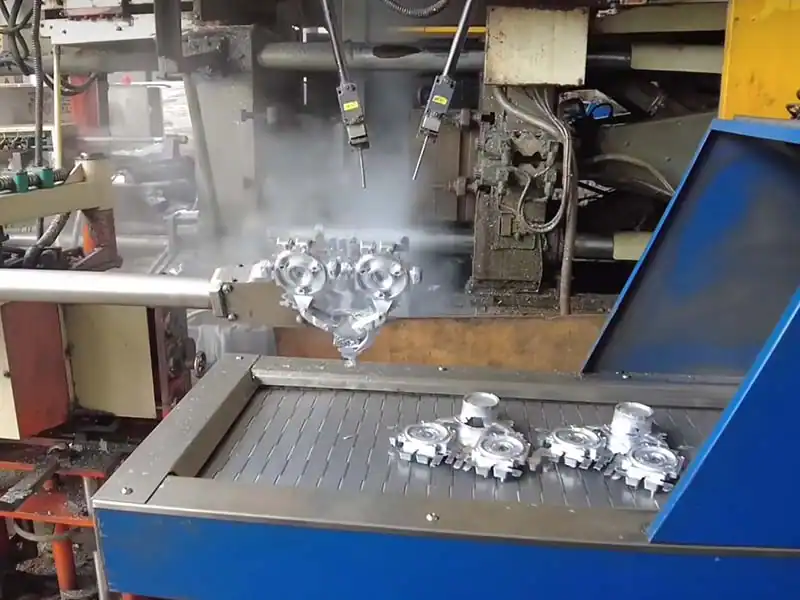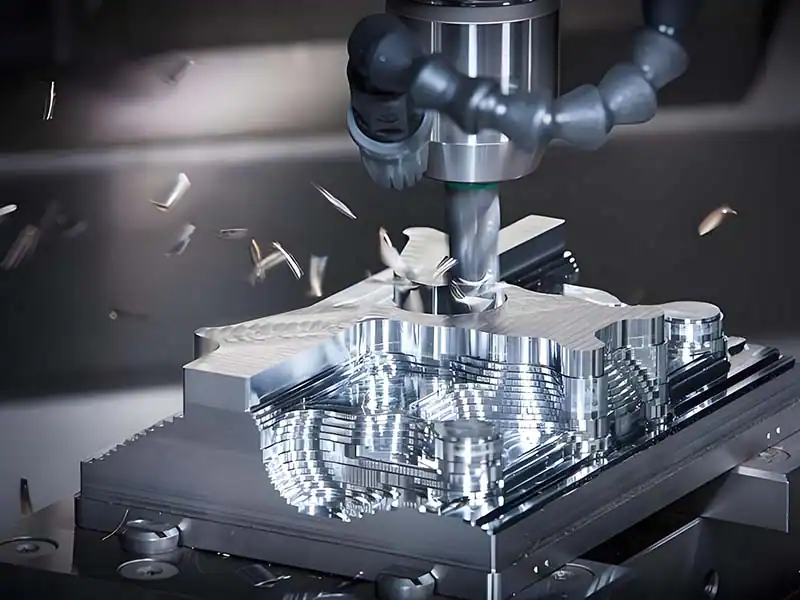Casting vs. machining: how to make the best choice?
Date: 2025-07-15 Categories: Blog Views: 141
In the world of manufacturing.cast (pour metal into a mold)respond in singingmachiningare two of the most basic and widely used part forming technologies. How do you make an informed choice between the two when faced with a specific part requirement? This is directly related to product quality, cost and lead time. In this article, we will analyze the core principles, advantages and disadvantages, key differences, and application scenarios of casting and machining to help you make a precise decision.
What is casting?
Casting is a time-honored manufacturing process that centers on thePouring molten metal (or alloy) into pre-prepared cavities (molds). The metal is cooled in the mold, solidifies and eventually forms a solid part with the shape of the mold cavity. This final part is called a "casting".
How does casting work?

aluminum castingHigh Pressure Die Castinggive birth to a child
The casting process consists of several key steps:
- Mold Manufacturing:?A mold (model) corresponding to the shape of the part is made from wood, metal, or other materials according to the part drawing. For cavity parts, it is also necessary to make a core that forms the inner cavity.
- Styling:?The mold is placed in a sand box and filled tightly with sand (or other modeling material) around the mold to form a casting cavity. When the mold is removed, the shape of the cavity is the negative shape of the desired part.
- Haplotype and Preparation:?The core (if required) is placed into the lower sand box, and the upper and lower sand boxes are then accurately brought together and secured to form a complete casting to be poured.
- Melting and pouring:?A pouring system that heats a metallic material above its melting point to melt it into a liquid state and then pours the molten metal smoothly into the casting mold.
- Cooling and solidification:?The molten metal cools within the casting mold and gradually changes from a liquid to a solid state.
- Sand fall and cleanup:?After the metal is completely solidified and cooled, the sand mold is broken (or the metal mold is opened) and the casting is taken out. Then a series of post-processing work such as removing the sprue, grinding the flying edge burr, cleaning the sand, surface treatment, etc. is carried out.
Advantages of casting
- High shape complexity:?Capable of producing parts with complex cavities, curved surfaces and shaped structures (e.g. engine blocks, pump housings, artwork).
- Wide range of materials:?Suitable for all kinds of metals and alloys, especially some difficult to machine materials.
- Large parts manufacturing:?It is the preferred method for producing large parts weighing from a few grams to hundreds of tons.
- Cost-effectiveness of batch production:?The cost per piece is usually lower than machining when producing large quantities.
- Good overall mechanical properties:?Castings can achieve nearly isotropic properties.
- Net shape or near net shape can be achieved:?Certain precision casting methods (e.g., investment casting, die casting) can result in castings with precise dimensions and clean surfaces, reducing the need for subsequent processing.
Disadvantages of casting
- Relatively low surface quality and precision:?Compared to machining, ordinary castings have rougher surfaces and usually lower dimensional and geometric accuracy (except for precision casting).
- Risk of internal defects:?Internal defects such as porosity, shrinkage, crumpling, inclusions, cracks, etc. may exist, affecting strength and sealing.
- High mold cost:?Manufacturing metal molds (especially die casting and investment casting) or complex wooden molds is costly and suitable for mass production.
- Longer production cycles:?The mold making and shaping process is time-consuming, especially for single parts or small batches.
- Material Limitations:?Certain high melting point, refractory metals or alloys are difficult to cast.
- Environmental Impact:?The melting process is energy intensive and may produce fumes and exhaust gases, and waste sand disposal is also problematic.
What is machining?

Machining Production
Machining (or machining, cutting) is a type ofGradual removal of excess material from workpiece blanks (e.g. bars, forgings, castings) by mechanical force using cutting toolsIt is a machining method to obtain the geometric shape, dimensional accuracy and surface quality required by the design. Common equipment includes lathes, milling machines, drilling machines, grinding machines, machining centers and so on.
Advantages of Machining
- High precision with high surface quality:?Very high dimensional and geometric accuracy and excellent surface finish can be achieved.
- Design flexibility:?Programming (CNC) enables rapid adaptation to design changes and the machining of complex surfaces and precision features.
- Wide applicability of materials:?It can process all kinds of metals, plastics and composite materials.
- Consistency and repeatability are good:?CNC machining, in particular, ensures a high degree of consistency for large quantities of parts.
- Excellent mechanical properties of parts:?The cutting process usually does not significantly change the properties of the material matrix (except for grinding), and work hardening sometimes improves surface hardness.
- Flexibility in small batch production:?No expensive tooling is required, making it particularly suitable for prototyping, small production runs and customized parts.
Disadvantages of machining
- There is a lot of material waste:?Removal of a large amount of material generates chips, and material utilization is relatively low.
- Difficulty in machining complex internal cavities and large thin-walled parts:?Limited tool accessibility, difficult to machine closed cavities; large thin-walled parts are prone to deformation.
- Production costs increase with complexity:?The more complex the shape and the higher the precision required, the more processing procedures, the longer the time consuming and the higher the cost.
- Batch production costs may be higher:?For high volume production, the cost per piece hour may be higher than casting.
- Residual stresses may be introduced:?The cutting process generates residual stresses on the surface and subsurfaces of the workpiece, which can affect dimensional stability or fatigue strength.
- Tool cost and wear:?Tools are consumables, especially when machining hard materials, they wear out quickly and the cost cannot be ignored.
Machining and casting: types and technologies
Types of machining
- Turning:?The workpiece rotates and the tool moves in a straight line. Used for machining cylindrical, conical, end faces, threads, etc.
- Milling:?The tool rotates and the workpiece moves. It is used for machining flat surfaces, grooves, gears, complex curved surfaces, etc. and is extremely versatile.
- Drilling:?A rotating drill bit machines round holes in the workpiece.
- Boring:?Enlarge or finish existing holes in the workpiece to improve accuracy and finish.
- Grinding:?Finishing with a high-speed rotating grinding wheel for ultra-high precision and finish.
- Specialty Machining:?Such as electric discharge machining (EDM), laser cutting, and water jet cutting for machining super-hard materials or complex shapes.
Types of casting
- Sand casting:?The most common, flexible and least costly method, using sand as the molding material. Accuracy and surface quality are average.
- Die casting:?Molten metal is pressed into precision metal mold cavities at high speed and high pressure. Suitable for large quantity, small and medium-sized thin-walled parts with complex shapes, with good precision and surface quality.
- Investment casting:?The mold is made of fusible material, covered with multi-layer refractory shell, and poured after melting away the model. High precision, smooth surface, can cast complex parts, suitable for high-temperature alloys.
- Metal mold casting:?Use of reusable metal molds (gravity casting). The quality of castings is superior to sand molds and the production efficiency is high.
- Low voltage/differential pressure casting:?Solidification under low pressure or pressure difference, high density castings.
- Centrifugal casting:?Liquid metal is poured into a high-speed rotating mold and shaped by centrifugal force. Used for tubular and ring-shaped parts.
Key differences between machining and casting
- Molds:
- Casting:?necessarily?A mold (sand, metal, etc.) is used to form the shape of the part. The cost of the mold is the main upfront investment.
- Machining:?needless?Dedicated molds corresponding to the shape of the part. Universal fixtures and cutting tools can be used. Upfront costs are mainly in equipment and programming.
- Precision and accuracy:
- Casting:?Ordinary methods (e.g., sand molding) have lower accuracy (tolerances at the millimeter level) and rougher surfaces. Precision casting (die casting, mold) can reach a higher precision (0.1mm tolerance) and finish, but still generally lower than machining.
- Machining:?Highest precisionThe standard machining can reach IT7-IT8 grade accuracy (0.01-0.05mm tolerance). Conventional processing can be up to IT7-IT8 level accuracy (0.01-0.05mm level tolerance), fine grinding, etc. can be up to IT5 level or even higher (micron level). Surface roughness can reach mirror effect.
- Material compatibility:
- Casting:?can handlegood mobilitymetal alloys. Certain high melting point, refractory, oxidizing alloys are difficult to cast. Plastics can also be injection molded (similar to casting).
- Machining:?Extremely wide range of applicable materials, almost all solid materials (metals, plastics, wood, composites) can be machined, as long as the tool is hard enough. Machining super-hard materials (e.g. carbide, ceramics) is inefficient and costly.
- Design complexity and size of the part:
- Casting:?Specializing in extremely complexshapes, especially parts with complex cavities, curved surfaces and thin-walled structures. It is the best way to manufactureLarge parts(e.g. machine tool bases, marine engine blocks)principalso much so thatuniqueMethods.
- Machining:?working (of machinery)Complex internal cavities and deep holes are very difficult(limited by tool length, diameter, and accessibility).Large thin-walled parts are easy to deform. Better at processing external geometric features or relatively open internal features.
- Production volume and speed:
- Casting:?Extremely fast mass production(especially die casting) with short cycle times for individual pieces.Slow and uneconomical to produce in small batches(High mold cost sharing).
- Machining:?Flexible and fast small batch production(no molds).Relatively slow mass production, single-piece machining time is long. Multi-axis CNC and automated production lines can improve efficiency.
- Part strength:
- Casting:?The casting may have defects such as porosity, shrinkage, etc., which reduce the fatigue strength as a stress concentration point. The grain structure is not as dense as forgings. But the integrity is good.
- Machining:?Usually rolled and forged billets are used, with dense, fiber-continuous material and mechanical properties (especially strength, toughness, fatigue strength)Usually better than castings. But cutting may cut the fiber flow line.
- Suitable for prototyping:
- Casting:?PrototypingHigh costs and long lead times(molds need to be made first), unless using a rapid casting technique such as 3D printed sand/molten molds. Not suitable for single piece prototyping.
- Machining:?Great for prototyping. No molds are required, and programming allows for quick translation of designs into physical objects, facilitating iterative design validation.
- Production costs:
- Casting:?High initial mold cost + lower marginal cost. For mass productionLowest cost per unit. Very high cost per piece in small quantities.
- Machining:?Low initial cost (no molds) + higher marginal cost (man-hours, tools). Small batch productionGood economy. Cost per piece may be higher than casting for large quantities.
- *Key point: cost break-even point.?There is usually an "economic production lot" threshold. Below this point, machining is more economical; above this point, casting is more economical. This point due to the complexity of the part, material, accuracy requirements vary greatly.
Areas of application for casting and machining
- Casting:?Automotive engine blocks/cylinder heads/transmission housings, pump and valve housings, turbine blades (melt molds), large equipment bases/frames, pipe fittings, works of art, cookware, aerospace structural components.
- Machining:?Precision gears, shaft parts, molds, precision instrument parts, optical device bases, hydraulic valve blocks, connectors, jigs and fixtures, parts requiring high-precision mating surfaces, and finishing processes for all types of parts.
Which one should I choose? Machining or casting?
There is no one-size-fits-all answer. Decision-making requires a comprehensive assessment of the following core factors:
- Production volume:
- Very small lot sizes (1 - dozens of pieces):?Almost always choose machining. Avoid high mold costs.
- Small to medium lot sizes (tens - hundreds of pieces):?Often more economical to machine. The cost of the mold may still be higher than the total cost of the machining when apportioned.
- Large quantities (thousands of pieces):?Casting (especially die casting) is usually the most cost effective. Tooling costs are greatly diluted, with the lowest cost of production per piece.
- *Attention:?There is a huge difference between the economic lot size thresholds for complex and simple parts. Simple parts may be suitable for casting in a few hundred pieces, while complex parts may require more than a few thousand pieces.
- Complexity of parts:
- Highly complex (especially with complex cavities, curved surfaces, thin walls):?Casting is preferred. Machining may not be possible or may be extremely costly.
- Relatively simple (dominated by external features such as shafts, disks, blocks):?Machining is more flexible and efficientThe most important thing to remember is that it's not just for small batches, it's also for small quantities.
- Moderately complex:?A detailed cost analysis is needed to compare the two processes.
- The required accuracy and repeatability:
- Extremely high precision (micron level) and perfect surfaces are required:?Must choose machining(especially grinding, fine milling and turning).
- High precision and good surface are required:?Precision casting (die casting, investment casting) may satisfyLibyan Arab JamahiriyaMachining is easier and more reliable to achieve.
- The accuracy requirements are average (tolerance > 0.2 mm):?Ordinary casting (sand molding) can meetThe cost is lower.
- Material Type:
- Good material flow, suitable for casting (e.g.aluminum(Zinc alloy, cast iron, copper alloy):?Casting is good option.
- The material is refractory, easily oxidized or has poor casting properties (e.g., certain titanium alloys, high melting point alloys):?Machining may be more feasible.
- Processing of non-metallic materials (plastics, composites) is required:?Machining is the main option(Plastic molding is similar to casting)
- The material is very expensive:?Casting (near-net shape) may reduce material wasteHowever, the scrap rate needs to be considered;High machining waste, but with a high yield. Comprehensive calculation is required.
- Material waste:
- Maximize material utilization is pursued:?near-net-shape casting(e.g., melt molds, precision sand molds) are less wasteful.
- The cost of materials is extremely high:?Both casting scrap (including pouring risers) and machining swarf need to be considered. A detailed accounting of net material consumption and scrap rates for both processes is required.
- Production speed (lead time):
- Prototypes or small batches are needed urgently:?Faster machining response(No mold making cycle time).
- Large quantities available quickly:?Once the molds are in place, casting (especially die casting) is extremely fast.The total delivery cycle may be shorter.
reach a verdict
Casting and machining are complementary, not competing, core manufacturing technologies. Casting, like the "from-scratch" master shaper, specializes in the efficient manufacture of complex, large parts at a low cost per part, especially in high-volume production. Machining, on the other hand, is the sculptor of "excellence," giving parts unmatched precision, finish, and design freedom, and is irreplaceable in low-volume and prototype production.
Wise choices begin with a thorough understanding of part requirements: In-depth analysis of production lot sizes, geometric complexity, accuracy requirements, material properties, cost objectives and lead times. Casting is often the economical choice for high-volume, complex shapes with less demanding accuracy requirements. For small lot sizes, high accuracy, frequent design iterations, or materials that are difficult to cast, machining is more advantageous. In many real-world applications, combining the two (cast blanks + machined finishes) often maximizes the benefits, striking the best balance between cost, efficiency and quality.
Frequently Asked Questions (FAQ)
- Q: Can I combine casting and machining?
A: Very common and recommended!?The vast majority of cast parts are machined to achieve final dimensional accuracy, surface finish, and critical mating surfaces (e.g., drilling holes, milling flats, turning threads). Casting provides the near-net-shape blank and machining completes the finish. This is standard practice to capitalize on the advantages of both. - Q: Will 3D printing (additive manufacturing) replace casting and machining?
A: In the short term, it will not be a complete replacement, but rather a complementary one.?3D printing excels in small-volume, extremely complex, customized prototypes and parts made of difficult-to-machine materials. However, casting and machining (subtractive materials) still have irreplaceable advantages in terms of high-volume production, cost-effectiveness, range of material choices, mechanical properties of parts (especially metals), and the manufacture of oversized parts.3D printing is also often used to make molds or cores for casting (rapid casting). - Q: Are there any alternatives to machining for small but very complex parts?
A: Yes.?Consider this:- Rapid casting technology:?The use of 3D printing to directly manufacture wax/resin molds for sand or investment casting eliminates the time and cost of traditional mold making and makes casting applicable to small quantities of complex parts.
- Metal 3D printing:?Direct printing of metal parts is particularly suitable for extremely complex structures that cannot be manufactured by conventional methods (e.g. follow-on cooling channels). However, there are still limitations in terms of cost, speed, size and material properties.
- Q: Which process produces stronger parts?
A: Generally, parts machined from forged or rolled billets are stronger and denser (especially for fatigue strength).?Castings may have internal defects (porosity, shrinkage) that affect strength. However, certain high-performance casting processes (e.g. isothermal forging + precision casting) can also result in high-strength parts. It depends on the material, process and quality control. - Q: What are the most important factors when choosing?
A: There is no single most important factor, but "production lot size" and "part geometric complexity" are usually the most critical starting points for cost effectiveness.?Next are accuracy requirements and materials. All relevant factors must be weighed in the final decision. For important projects, a detailed process cost analysis (DFM - Design for Manufacturing) is essential.

























